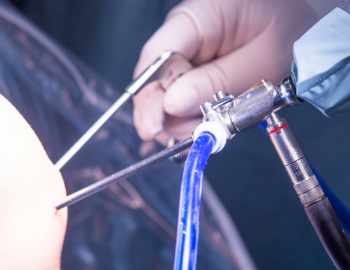Arthroscopic meniscectomy is a surgical keyhole procedure to remove all or part of the meniscus of the knee.
 Page updated December 2023 by Dr Sheila Strover (Clinical Editor)
Page updated December 2023 by Dr Sheila Strover (Clinical Editor)

Is arthroscopic meniscectomy a major procedure?
A meniscectomy may be a trimming of the meniscus, a partial meniscectomy - where only part of the meniscus is removed - or a full meniscectomy where the whole of the meniscus is removed. The surgeon will generally try to preserve the important outer rim of the meniscus.
Recovery may still take a bit of time as the joint is inflated during the procedure with a modified saline solution under pressure, so there may be some swelling and stiffness, but it should soon resolve. Physiotherapy will still be necessary as the quadriceps muscle may become inhibited and there may be residual issues relating to the initial injury any period of immobility.
Importance of preserving the outer rim
Because of the distribution of fibres in the meniscus, the outer rim carries most of the load that is supported by the meniscus. If the inner edge is trimmed, it won't make a huge difference to the knee, but if the outer rim is damaged then there is a strong chance of the knee developing arthritis.
The controversy about trimming degenerate tears
Initially there was a great deal of conroversial debate when papers were published to show that degenerate tears do show improvement in symptoms after arthroscopic partial meniscectomy, and results were no better than washing of the joint. This has settled and most surgeons will avoid trimming a torn meniscus in the older person on the assumption that the tear is degenerate..
Quick links
Forum discussions
- "I wish I'd never had surgery! Just want to look after my kids again!"
Patients discover that no decision is simple when it comes to knee surgery.
Peer-reviewed papers
-
Quote:
"In a large study...designed to ascertain whether APM [arthroscopic partial meniscectomy] is superior to placebo surgery in treating patients with knee pain and a degenerative meniscus tear....[n]o statistically significant difference was found between the two groups."
Citation: Sihvonen R, Paavola M, Malmivaara A, Itälä A, Joukainen A, Nurmi H, Kalske J, Ikonen A, Järvelä T, Järvinen TAH, Kanto K, Karhunen J, Knifsund J, Kröger H, Kääriäinen T, Lehtinen J, Nyrhinen J, Paloneva J, Päiväniemi O, Raivio M, Sahlman J, Sarvilinna R, Tukiainen S, Välimäki VV, Äärimaa V, Toivonen P, Järvinen TLN; FIDELITY (Finnish Degenerative Meniscal Lesion Study) Investigators. Arthroscopic partial meniscectomy versus placebo surgery for a degenerative meniscus tear: a 2-year follow-up of the randomised controlled trial. Ann Rheum Dis. 2018 Feb;77(2):188-195. doi: 10.1136/annrheumdis-2017-211172. Epub 2017 May 18. PMID: 28522452; PMCID: PMC5867417.
-
Quote:
"[BUT]...knee arthroscopy has a role in the management of targeted lesions and in certain situations where non-operative measures have proved unsuccessful."
Citation: LaPrade RF, Spalding T, Murray IR, Chahla J, Safran MR, Larson CM, Faucett SC, von Bormann R, Brophy RH, Maestu R, Krych AJ, Firer P, Engebretsen L. Knee arthroscopy: evidence for a targeted approach. Br J Sports Med. 2020 Dec 7;55(13):707–8. doi: 10.1136/bjsports-2020-103742. Epub ahead of print. PMID: 33288619; PMCID: PMC8223657.
Other relevant material -
Primer -
- 2011 - Meniscus Primer - by Dr Sheila Strover (Clinical Editor)
From the Experts -
- Expert view - 2017 - What is meniscus preservation and why does it matter? - by Prof Raju Vaishya (Knee Surgeon)
- Journal interpretation - 2021 - The future of meniscus science: international expert consensus by DePhillipo NN et al. - interpreted for you by Dr Sheila Strover (Clinical Editor)